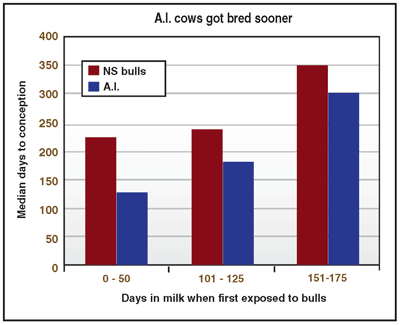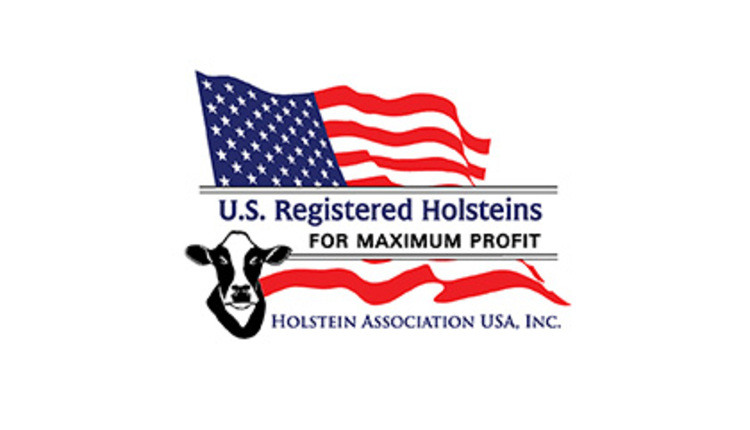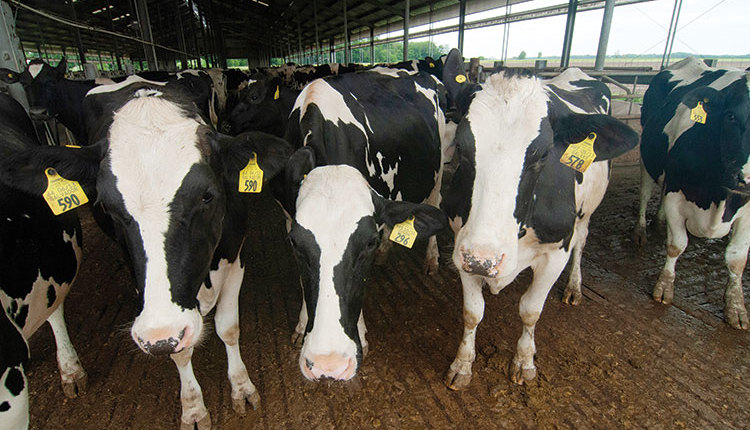The author is professor of animal sciences at Kansas State University, Manhattan.
With today's poor farm milk prices, everyone is looking for ways to cut costs to survive. Often, that search leads one to believe that abandoning A.I. breeding might save money in the short run while still maintaining conception rates.
Some dairymen have chosen to use natural service (NS) sires, either wholly or in part. Surveys of dairy producers report between 55 and 96 percent used NS bulls in part for impregnating their milk cows. Of herds processed at the Dairy Records Management System in Raleigh, N.C., during 1999 to 2002, only 1 percent of herds used NS bulls exclusively, whereas 26 percent used only A.I. breeding. This indicates that about 73 percent of herds use a combination both A.I. breeding and NS bulls.
What advantages or disadvantages does A.I. breeding provide to your reproductive management program? The obvious benefits of using A.I. breeding rather than NS bulls include reducing risk of transmitting venereal disease, boosting rate of genetic gain for milk yield and many other heritable traits of economic significance such as longevity. Let's look at these issues in more detail.

Genetic improvement . . .
Records show that between 1984 and 1998 that A.I.-proven sired daughters produced 807 to 979 pounds more milk than daughters of NS bulls. Most of the dairy record processing centers provide genetic information about all the females in the herd. If you are progressive in using A.I.-proven sires, you'll discover that genetic estimates are greater for the youngest females in your herd.
For example, in our herd, average Net Merit $ for our youngest replacement heifers (0 to 12 months) is +245 and for those heifers 13+ months of age, Net Merit $ is slightly less (+228). Those averages are greater than those for first- (+201), second- (+214), and third-plus (+199) lactation cows. If one were using NS bulls to a large extent, these estimates would be less. In the long-run, abandonment or significantly less use of A.I. breeding would result in less productive daughters.
Fertility is an issue . . .
Many dairy producers believe that cows become pregnant faster when exposed to NS bulls. Is that really true? A study compared calving to conception intervals for cows in A.I. pens with cows exposed to bulls while controlling for milk yield, lactation number, herd, mastitis, and seasonal effects. This study consisted of 10 commercial California herds with a total of 20,580 Holstein cows. Seven dairies had typical, western four-row free stall barns with dirt exercise lots adjoining the free stall barns. The remaining three were dry-lot dairies with fixed shade structures. Cows were grouped into cohorts based on days in milk that they were moved into bull pens: 1-50, 51-75, 76-100, 101-125, 126-150, 151-175, 176-200, and 201-225. Rate at which these cows became pregnant was then compared with open cows that remained in the A.I. pens.
Compared with cows exposed to NS bulls starting between calving and 50 days in milk, 101 and 125, and 151 and 175 days in milk, cows exposed to A.I. breeding had fewer median days to conception (see figure). In other words, A.I.-bred cows got pregnant sooner.
A.I.-exposed cows in 6 of 7 cohorts had greater 305 ME milk yield than those cows exposed to bulls, with the most pronounced differences among cows early in milk. In all the analyzed cohorts, the A.I.-exposed cows were 1.3 to 1.9 times more likely to have fewer days to conception compared with bull-exposed cows.
Their results also indicated that three times more cows were moved to bull-breeding pens during the first 50 days in milk compared with those moved to bull pens between 51 and 100 days. This is consistent with reasons why dairymen move certain cows to bull pens based on a combination of number of times inseminated, days in milk, current milk yield, and expectations that cows will be hard breeders. The authors concluded that keeping cows in the A.I. pens longer, before exposing them to clean-up bulls, may improve pregnancy rates, despite the potential decline in expected conception rates.
Another study assessed pregnancy rates and milk yield in herds in which both NS and (or) A.I. were practiced. Based on seven years of DHIA records of Holstein cows located in Florida and Georgia, 70 percent of the herds used NS bulls as a component of their breeding program. During winter, pregnancy rates in A.I. herds (17.9 percent) did not differ from that for mixed (A.I. + NS) herds (17.8 percent) and NS herds (18 percent). During summer, pregnancy rates for A.I. herds (8.1 percent) was slightly less than that for mixed (9.3 percent) and NS herds (9.8 percent).
Rolling herd average milk yield, however, was less in NS herds (15,829 pounds) compared with A.I. (18,768 pounds) and mixed herds (18,025 pounds), but annual change in milk production was not different among breeding systems. The authors concluded that use of NS bulls did not result in meaningful advantage in terms of pregnancy rate and changes in milk production over time.
Returns . . .
The bottom-line net cost per cow of using NS bulls in one 2005 cost-comparison study was $10.27 more than using an A.I. program. Results from the model showed that approximately 60 percent of the time, A.I. was predicted to cost less than using NS sires. Ninety percent of the time the true estimate of difference between the two breeding systems was between a $77 advantage for A.I. to a $55 advantage by using NS sires. This variation resulted primarily from differences in Net Merit $ estimates for A.I. versus NS bull, price of milk for marginal cows, and price of market cows.
Advantages for A.I. breeding far outweigh using NS bulls. Don't forget the safety issues that are associated with keeping NS bulls in cow pens! A.I. breeding is an investment in your future.
Click here to return to the Reproduction E-Sources
090910_568
With today's poor farm milk prices, everyone is looking for ways to cut costs to survive. Often, that search leads one to believe that abandoning A.I. breeding might save money in the short run while still maintaining conception rates.
Some dairymen have chosen to use natural service (NS) sires, either wholly or in part. Surveys of dairy producers report between 55 and 96 percent used NS bulls in part for impregnating their milk cows. Of herds processed at the Dairy Records Management System in Raleigh, N.C., during 1999 to 2002, only 1 percent of herds used NS bulls exclusively, whereas 26 percent used only A.I. breeding. This indicates that about 73 percent of herds use a combination both A.I. breeding and NS bulls.
What advantages or disadvantages does A.I. breeding provide to your reproductive management program? The obvious benefits of using A.I. breeding rather than NS bulls include reducing risk of transmitting venereal disease, boosting rate of genetic gain for milk yield and many other heritable traits of economic significance such as longevity. Let's look at these issues in more detail.

Genetic improvement . . .
Records show that between 1984 and 1998 that A.I.-proven sired daughters produced 807 to 979 pounds more milk than daughters of NS bulls. Most of the dairy record processing centers provide genetic information about all the females in the herd. If you are progressive in using A.I.-proven sires, you'll discover that genetic estimates are greater for the youngest females in your herd.
For example, in our herd, average Net Merit $ for our youngest replacement heifers (0 to 12 months) is +245 and for those heifers 13+ months of age, Net Merit $ is slightly less (+228). Those averages are greater than those for first- (+201), second- (+214), and third-plus (+199) lactation cows. If one were using NS bulls to a large extent, these estimates would be less. In the long-run, abandonment or significantly less use of A.I. breeding would result in less productive daughters.
Fertility is an issue . . .
Many dairy producers believe that cows become pregnant faster when exposed to NS bulls. Is that really true? A study compared calving to conception intervals for cows in A.I. pens with cows exposed to bulls while controlling for milk yield, lactation number, herd, mastitis, and seasonal effects. This study consisted of 10 commercial California herds with a total of 20,580 Holstein cows. Seven dairies had typical, western four-row free stall barns with dirt exercise lots adjoining the free stall barns. The remaining three were dry-lot dairies with fixed shade structures. Cows were grouped into cohorts based on days in milk that they were moved into bull pens: 1-50, 51-75, 76-100, 101-125, 126-150, 151-175, 176-200, and 201-225. Rate at which these cows became pregnant was then compared with open cows that remained in the A.I. pens.
Compared with cows exposed to NS bulls starting between calving and 50 days in milk, 101 and 125, and 151 and 175 days in milk, cows exposed to A.I. breeding had fewer median days to conception (see figure). In other words, A.I.-bred cows got pregnant sooner.
A.I.-exposed cows in 6 of 7 cohorts had greater 305 ME milk yield than those cows exposed to bulls, with the most pronounced differences among cows early in milk. In all the analyzed cohorts, the A.I.-exposed cows were 1.3 to 1.9 times more likely to have fewer days to conception compared with bull-exposed cows.
Their results also indicated that three times more cows were moved to bull-breeding pens during the first 50 days in milk compared with those moved to bull pens between 51 and 100 days. This is consistent with reasons why dairymen move certain cows to bull pens based on a combination of number of times inseminated, days in milk, current milk yield, and expectations that cows will be hard breeders. The authors concluded that keeping cows in the A.I. pens longer, before exposing them to clean-up bulls, may improve pregnancy rates, despite the potential decline in expected conception rates.
Another study assessed pregnancy rates and milk yield in herds in which both NS and (or) A.I. were practiced. Based on seven years of DHIA records of Holstein cows located in Florida and Georgia, 70 percent of the herds used NS bulls as a component of their breeding program. During winter, pregnancy rates in A.I. herds (17.9 percent) did not differ from that for mixed (A.I. + NS) herds (17.8 percent) and NS herds (18 percent). During summer, pregnancy rates for A.I. herds (8.1 percent) was slightly less than that for mixed (9.3 percent) and NS herds (9.8 percent).
Rolling herd average milk yield, however, was less in NS herds (15,829 pounds) compared with A.I. (18,768 pounds) and mixed herds (18,025 pounds), but annual change in milk production was not different among breeding systems. The authors concluded that use of NS bulls did not result in meaningful advantage in terms of pregnancy rate and changes in milk production over time.
Returns . . .
The bottom-line net cost per cow of using NS bulls in one 2005 cost-comparison study was $10.27 more than using an A.I. program. Results from the model showed that approximately 60 percent of the time, A.I. was predicted to cost less than using NS sires. Ninety percent of the time the true estimate of difference between the two breeding systems was between a $77 advantage for A.I. to a $55 advantage by using NS sires. This variation resulted primarily from differences in Net Merit $ estimates for A.I. versus NS bull, price of milk for marginal cows, and price of market cows.
Advantages for A.I. breeding far outweigh using NS bulls. Don't forget the safety issues that are associated with keeping NS bulls in cow pens! A.I. breeding is an investment in your future.
090910_568










